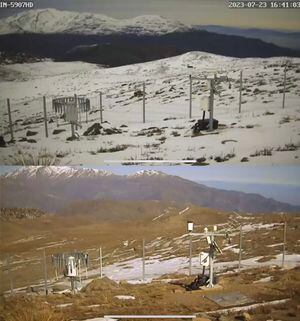“Winter in Chile is disappearing in terms of temperature and rainfall.” Words Raúl Cordero, a climatologist at the University of San Diego, They describe a trend of increasing frequency. In Chile, this week marks the ninth heat wave of the year and the second of this winter. Temperatures in the commune of Vicuña unexpectedly reached 37°C, leading to Life has changed significantly in the northern and central parts of the country.
While experts admit the high winter temperatures are not unique, they are part of a series of heat waves, These have had and will have serious impacts on people’s health, access to water, and the agriculture and fruit industries. How can the consequences of an increasingly drier and hotter climate be contained or reversed?

According to data from the World Meteorological Organization (WMO) and the European Union’s Copernicus Climate Service, July is the hottest month on record on Earth. This record could change the planet this year 16.95°C above its average temperature2023 is increasingly likely to be the hottest year on record, surpassing the record set in 2016.
This situation affects the entire planet. The temperature in Phoenix, Arizona, USA has exceeded 43°C for more than 20 consecutive days. In Death Valley, California, a temperature of 55°C was recorded. To date, 27 percent of the U.S. population, or 91 million people, have been affected by this extreme heat wave.
The situation in Europe is similar. Countries such as Italy, Cyprus, Croatia, Greece and Spain had extreme temperatures of around 40°C, The same is true of Japan and China. The temperature in the latter city of Sanbao was 52.2 degrees Celsius.

in Chile, and Although we are in the midst of winter, much of the country is experiencing an unusual winter heat wave with unusual heat records. According to Raúl Cordero, a climatologist at the University of San Diego, Global warming and El Niño are pushing global temperatures to record levels.
“All the heat in the central and north-central regions is a direct result of the mountain winds. Weather conditions in the Southern Cone are currently favorable for strong winds. The Andes create high temperatures. This is because when these winds blow down the slope, they are compressed, and when the air is compressed, it heats up,” Cordero explained.
But according to climatologists, there is an ultimate reason, related to global warming. “It’s causing temperature records to be broken around the world, and Chile’s situation is no longer an exception.“, it noted.

One of the regions that did well was the Little North region. According to climate historian Maximiliano HerreraSouth America is experiencing one of the worst events in the world. “In mid-winter, the temperature in the Chilean Andes reached an unbelievable 38.9°C! Much more serious than what just happened in southern Europe at the same height in midsummer: an event that is rewriting all the climate books,” he wrote via his X account (formerly Twitter).
Extremely hot conditions in the Andes confirmed The Chilean Meteorological Service also stated through its statement that the Vicuña Los Pimientos station (DMC-DGAC) The temperature in the Coquimbo area is 37°C, lThe nation’s second highest temperature on record in winter. In August 1951, the highest temperature recorded in Copiapo was 37.3 °C.
The consequences of this unusual weather It also has an impact on agricultural production in the region. University of Chile scholar and climate change expert Fernando Santibanez said, These early heat waves are not good at all. “Whether it’s from an agricultural point of view, or from a hydrological point of view. That’s because, on the other hand, they tend to bring plant species out of “winter rest” early, by melting the snow earlier than we need as much water.“, explain.

Academic details suggest that plants awaken from dormancy at this expected high temperature to become active, sprouting and flowering earlier. According to Santi Barnes, This is not good for two reasons: “They are still exposed to frost that may still occur, On the other hand, trees need a period of rest before they can fully flower, bloom well, and produce fruit normally.”
When this does not happen, then Production volumes have decreased and fruit quality has declined, which will also negatively affect fruit exports.
San Diego temperature The maximum temperature on 1 August reached 23°C, nearly 7° above typical. “These types of heat waves were uncommon 20 or 30 years ago, but heat waves have tripled in the past 40 years. Only now it has reached an intensity that compels us to pay attention to it.“, a quote from Codero.

In addition, experts emphasized that the lack of snowfall in the Andes due to the winter heat wave is worrying. “If we lose snowfall because of heatwaves and drought, then we’re going to be vulnerable in the dry spells of spring and summer.’, he showed. Records from the University of San Diego’s snow monitoring station show How much the water level in the Yerba loca reserve at 2,700 meters dropped in a week:
Santi Banez explained We’ve had a snow deficit compared to previous years. “With such high temperatures, if they move further south, they could be a factor in the expected snowpack melt, There will definitely be a shortage of water in summer”he warned.
Although, on the other hand, heRainfall forecasts say that spring and summer precipitation is still likely to continue to decrease, as the El Niño phenomenon will continue throughout the summer. Given this, Santi Banez commented that it is possible New snow on ridges offsets early melt.Although the academic expects El Niño rains to make up for the lack of snow due to the heat, he explained Precipitation in spring and summer is the most detrimental to fruit crops.

Although the temperatures brought on by winter heat waves are not yet high enough to affect human health, it would be a mistake to think of them as pleasant. They have very negative effects on the climate system. “Especially the abnormally high temperature in winter accelerates the melting of summer snow on which spring and summer depend, supply drinking water to the big cities in the central region,” says Cordero.
Considering that El Niño is expected to last at least until the first quarter of next year,”We are likely to experience an unusually hot summer. The above means Chile’s next fire season could be as active as last“Add to.
But are warmer winter temperatures having health consequences? orn A report by the National Environmental Education Foundation. Including the main health effects of warmer winter temperatures. As they explain, Not only do you not need to wear as much clothing when you go out, but it can also affect weather patterns and thus human health.

first, Unhealthy Air Can Make Asthma Worse directly cause or aggravate respiratory disease. In addition, higher temperatures lead to increases in tropospheric ozone, and their exposure increases the frequency and severity of attacks from tropospheric ozone. Asthma, nasal and eye irritation, cough, bronchitis, and respiratory infection.
In addition, the temperature rises, Combined with higher levels of carbon dioxide could make allergy season earlier and last longer.this Higher pollen counts and longer pollen seasons can increased allergy symptomswhich leads to people who are struggling with asthma being affected by this climate change.
On the other hand, the NEEF report warned that an unusually warm winter could lead to an extreme heat wave in the coming summer. In addition, a warming climate means disease-carrying insects are likely to emerge earlier and in new geographic areas. The most common insect-borne diseases are found in Fleas, Ticks and Mosquitoes.

Increases in temperature and precipitation could lead to increased outbreaks of infectious diseases such as cholera, diarrhoea, salmonella and campylobacteriosis.according to a report World Health Organization, Between 2030 and 2050, climate change is projected to cause Heat stress, malaria, malnutrition and diarrhea kill an additional 250,000 people each year.
“We’ve got to take a series of actions and see how we’re going to adapt to this new situation,” Santibanez said before the situation emerged. As he concluded, this is not a task that farmers alone can accomplish, nor can the state itself. It needs the contribution of the college to release knowledge, the state to release means of promotion, and farmers Make changes to safeguard our ability to produce food.
